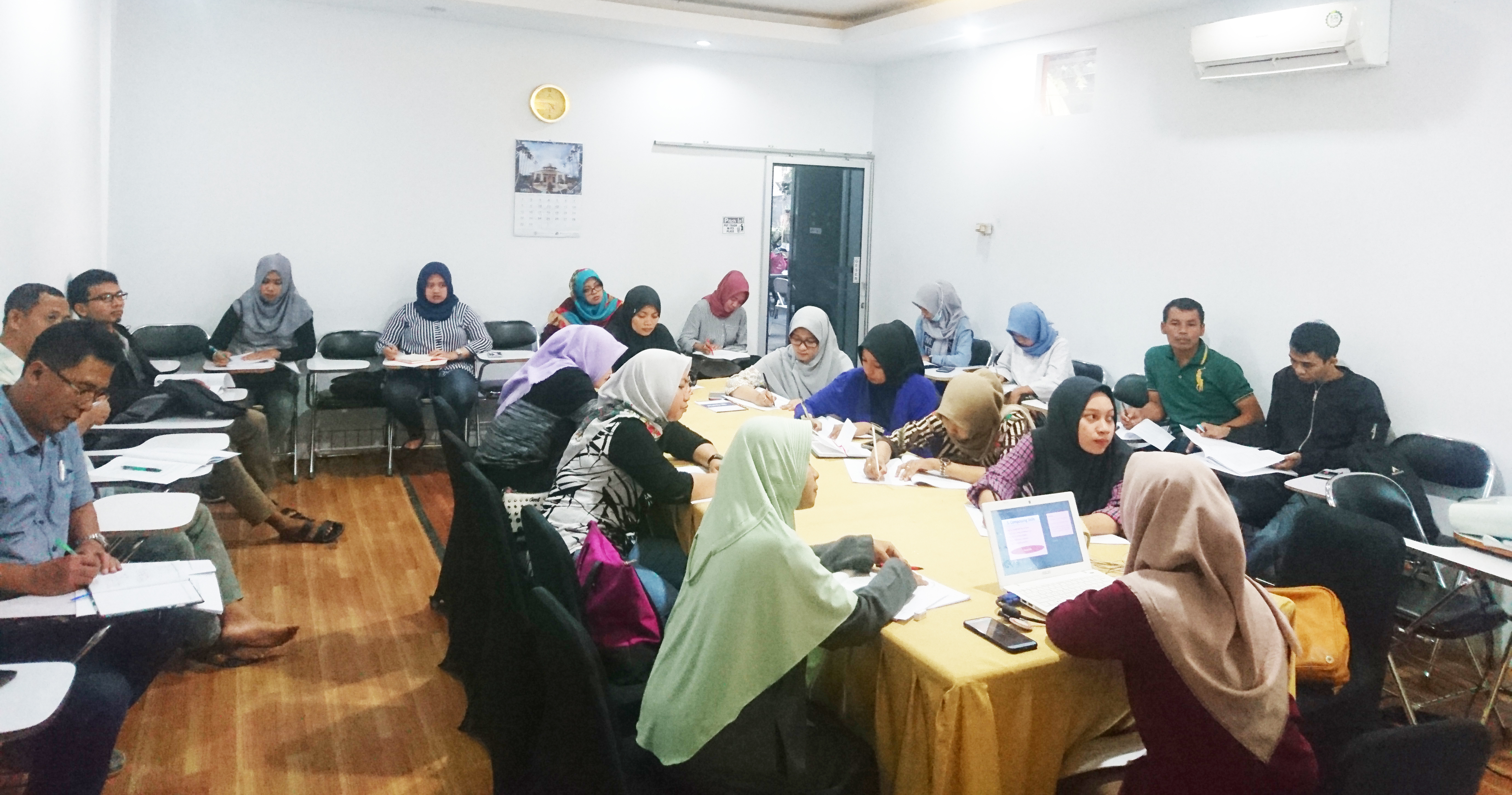
GENERAL STRATEGIES FOR LISTENING COMPREHENSION
GENERAL STRATEGIES FOR LISTENING COMPREHENSION
- Be familiar with the direction.
- Listen carefully to the passages.
- Know where easier and the more difficult questions are generally found.
- Be familiar with the pacing (time) of the test.
- Never leave any answers blank on your answer sheet.
- Use any remaining time to look ahead at the answers to the questions that follow.
PROCEDURES FOR THE SHORT DIALOGUES
- As you listen to each short dialogue, focus on the second line of the conversation. The answer to the question is generally found in the second line.
- Keep in mind that the correct answer is probably a restatement of a key word or idea in the second line of the dialogue. Think of possible restatements.
- Keep in mind that certain structures and expressions are tested regularly in the short dialogues. Listen for these structures and expressions;
- Structures (passives, negatives, wishes, conditions).
- Functional expressions (agreement, uncertainty, suggestion, surprise).
- Idiomatic expressions (two-part verbs, three-part verbs, idioms).
- Keep in mind that these questions generally progress from easy to difficult. This means that questions 1 through 5 will be the easiest and questions 26 through 30 will be the hardest.
- Read the answers and choose the best answer to each question. Remember to answer each question even if you are not sure of the correct response. Never leave any answers blank.
- Even if you do not understand the complete dialogue, you can still find the correct answer.
- If you only understand a few words or ideas in the second line, choose the answer that contains a restatement of those words or ideas.
- If you do not understand anything at all in the second line of the conversation, choose the answer that sounds the most different from what you heard.
- Never choose an aswer because it sounds like what you heard in the dialogue.
- Be prepared for the next question. You have only 12 seconds between questions.
STRATEGIES
- FOCUS ON THE LAST LINE
- The last line of the dialogue probably contains the answer to the question.
- Listen to the first line of the dialogue. If you understand it, it’s good. If you do not understand it, don’t worry because it probably does not contain the answer.
- Be ready to focus on the last line of the dialogue because it probably contains the answer. Repeat the last line in your mind as you read through the answers in the text.
- CHOOSE ANSWER WITH SYNONYMS
- As you listen to the last line of the dialogue, focus on key words in that line.
- If you see any synonyms for key words in a particular answer, then you have probably found the correct answer.
- AVOID SIMILAR SOUNDS
- Identify key words in the last line of the dialogue.
- Identify words in the answers that contain similar sounds, and do not choose these answers.
- DRAW CONCLUSIONS ABOUT WHO, WHAT, WHERE\
It is common for you to be asked to draw one of the following conclusions in the short dialogues:
- WHO is probably talking?
- WHAT will she/ he probably do next?
- WHERE does the dialogue probably take place?
- LISTEN FOR WHO AND WHAT IN PASSIVES
- if the dialogue contains a passive statement, the answer to the question is often an active statement.
- if the dialogue contains an active statement, the answer to the question is often a passive statement.
Note: check carefully who or what is doing the action in these questions.
- LISTEN FOR WHO AND WHAT WITH MULTIPLE NOUNS
When there are multiple nouns in a sentence, it is common for the answers to confuse which noun does what.
- LISTEN FOR NEGATIVE EXPRESSIONS

- LISTEN FOR DOUBLE EXPRESSIONS

- LISTEN FOR “ALMOST NEGATIVE” EXPRESSIONS

- LISTEN FOR NEGATIVE COMPARATIVES

- EXPRESSIONS OF AGREEMENT

- EXPRESSIONS OF UNCERTAINTY AND SUGGESTION

- EMPHATIC EXPRESSION OF SURPRISE

- CONTRARY MEANINGS

- UNTRUE CONDITION

- IDIOMATIC LANGUAGE
Two- and three – part verbs
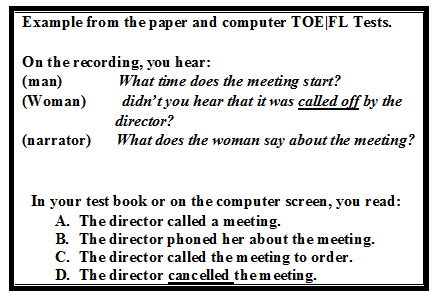
Idioms
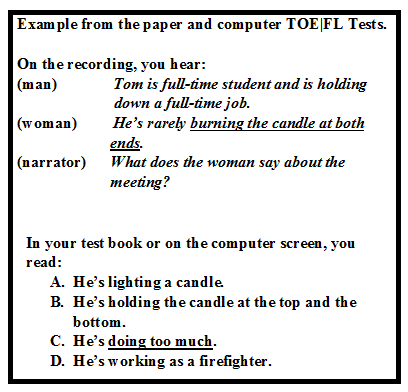
Procedure for LONG CONVERSATION, it is very important for listeners to take time by previewing the multiple choices and trying to guess the topic. When they try to draw the conclusion: to guess who is talking, where the conversation takes place, when it takes place, what course the talk is concerned with, what the source of information for the talk is. If they are not really sure with the answers, please don’t leave any answers blank.
In addition, you can only listen to the long conversation without paying attention to the multiple choices. If that method works well for you, then it what you should do. On the other hand, you can answer more questions correctly if you read along with the answers while the talk is being given. It depends on you, which is better for you.
PROCEDURE FOR STRUCTURE QUESTIONS
- Be sure a sentence has a subject and a verb.
- Be careful of objects of prepositions. (An object of a preposition is a noun, pronoun, gerund, or noun clause that comes after a preposition, such as in, at, of, to, by, behind, on, and so on, to form a prepositional phrase. E.g. : after his exams, Tom will take a trip by boat. If a word is an object of a preposition, it is not the subject.
- Be careful of appositives.
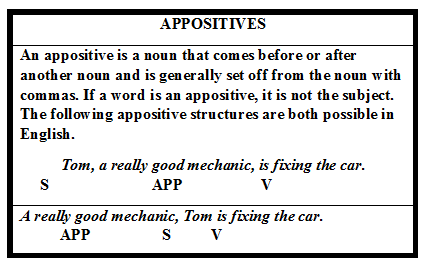
- Be careful of Present Participle
A present participle is the –ing form of the verb (talking, playing). In structure questions, a present participle can cause confusion because it can be either a part of the verb or an adjective. It is part of the verb when it is preceded by some form of the verb be.
The man is talking to his friend.
Verb
In that sentence talking is part of the verb because it is accompanied by is.
A present participle is an adjective when it is not accompanied by some form of the verb be.
The man talking to his friend has a beard.
Adjective
In this sentence talking is an adjective and not part of the verb because it is not accompanied by some form of be. The verb in this sentence is has.
- Be careful of Past Participles

- Sentences with multiple clauses.
- Use coordinate connectors correctly
When you have two clauses in an English sentence, you must connect the two clauses correctly. One way to connect two clauses is to use and, but, or, so, or yet between the clauses.
In each of these examples, there are two clauses that are correctly joined with a coordinate conjunction and, but, or, so, or yet, and a comma (,).
For example:
A power failure occurred, … the lamps went out.
- then
- so
- later
- next
- Inverted Subjects and Verbs with Negatives.
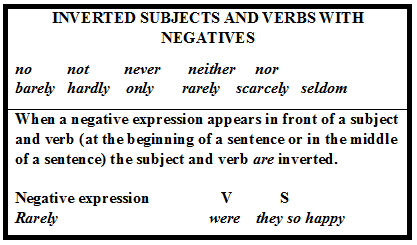
- Make an agreement of subject and verb.
- Make verbs agree after certain words.
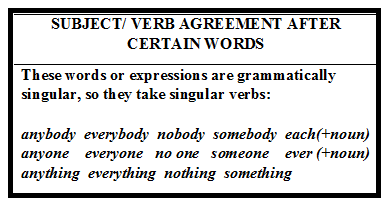
- Parallel Structure
e.g., I like to sing and to dance.
I like singing and dancing.
- Parallel Structure


 0857 2626 7001
0857 2626 7001

